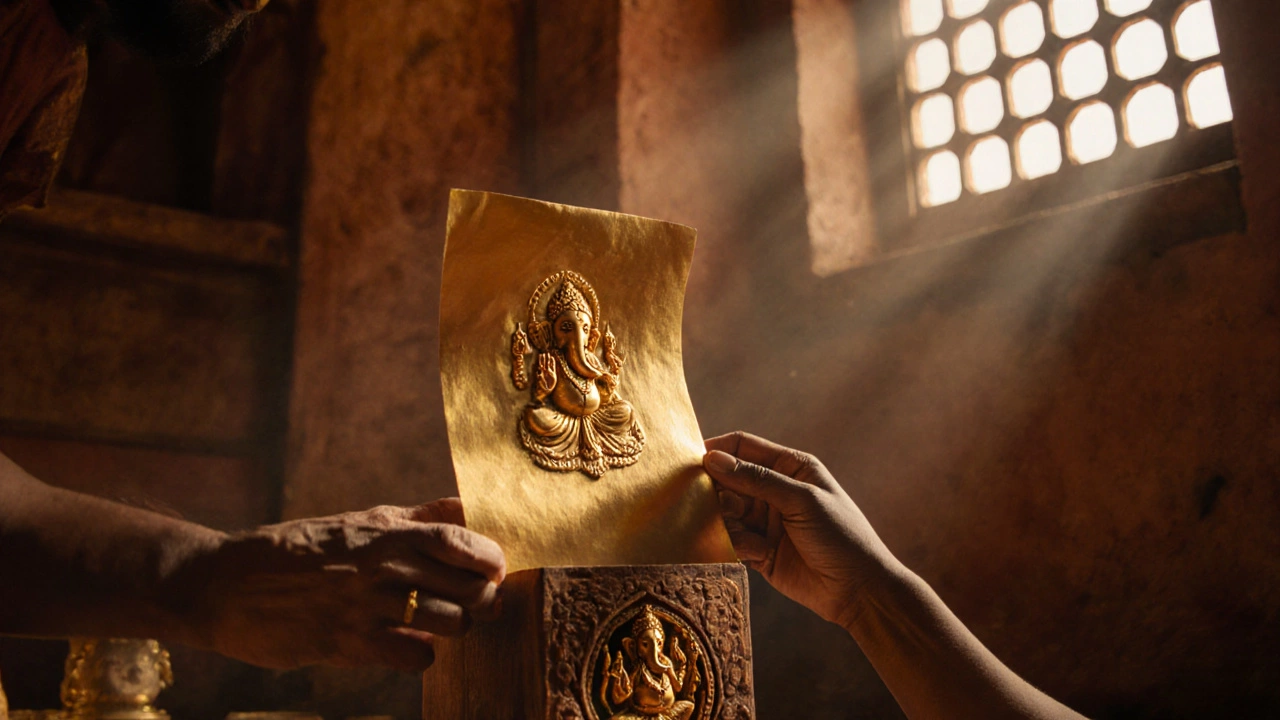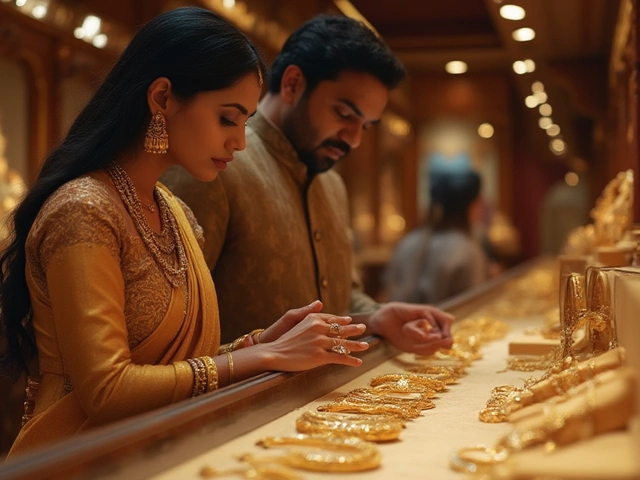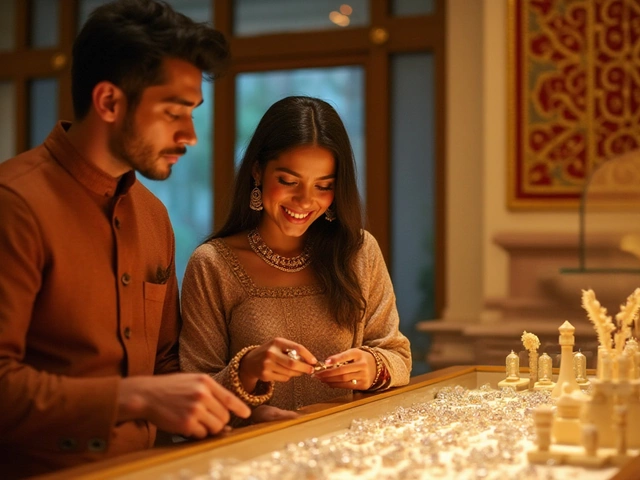Temple Jewelry Gold Value Calculator
Calculate the approximate value of your temple jewelry based on gold purity, weight, and current market price. This tool helps you understand the value of your jewelry for insurance, sale, or gifting purposes.
Calculation Results
Enter your jewelry details to see the estimated value
About Temple Jewelry Purity
22-karat gold (916) is the most common purity for South Indian temple jewelry, offering a rich golden color with good durability. This is the standard for traditional bridal sets and religious pieces.
18-karat gold (750) contains more alloy metals, making it harder and more suitable for intricate designs. This is popular in North Indian styles where lighter pieces are preferred.
14-karat gold (585) is less common for traditional temple jewelry but may be used for modern adaptations. It offers the highest durability but has a lighter gold color.
Key Takeaways
- Temple jewelry is primarily made from gold, silver, copper or brass, often in 22‑k or 18‑k grades.
- Gemstones such as kundan, pearls, navaratna and enamel work add colour and symbolic meaning.
- Regional styles influence material choices - South Indian pieces favour heavier gold, while North Indian designs may use more silver.
- Understanding the material mix helps you assess value, durability and proper care.
- Look for hallmark stamps, weight checks and trusted sellers to confirm authenticity.
What Is Temple Jewelry?
When you hear Temple jewelry is a traditional Indian style of ornaments inspired by Hindu temple sculptures, featuring intricate motifs of deities, flowers, and mythic creatures, you probably picture gold pieces glittering on a bride’s wrists. But the truth is that temple jewelry can be crafted from a mix of metals and stones, each chosen for its look, meaning, and durability.
The style first emerged in the 13th‑15th centuries when temple artisans began creating wearable versions of the elaborate carvings seen in South Indian temples. Over time, the designs migrated to the courts of Mysore, Hyderabad and Kolkata, evolving into the iconic bridal sets we see today.
Core Metals Used in Temple Jewelry
Gold is a pure yellow metal (often 22‑k or 18‑k in India) prized for its natural shine and cultural value. In South India, 22‑k gold is the default because it matches the bright, radiant look of temple deities. The metal’s malleability allows artisans to carve tiny detailing without breaking the piece.
Silver is a softer white metal that offers a cooler contrast to gold. Silver is popular in North Indian and Gujarati temple pieces, especially for bangles and anklets. Because silver tarnishes over time, many designers coat it with a thin layer of rhodium for extra shine.
Copper and brass are also common, usually as a base alloy beneath gold or silver plating. These base metals reduce cost while still delivering the same weight feel. A typical 18‑k gold piece may contain 75% gold, 15% copper and 10% silver - a blend that improves hardness without sacrificing colour.
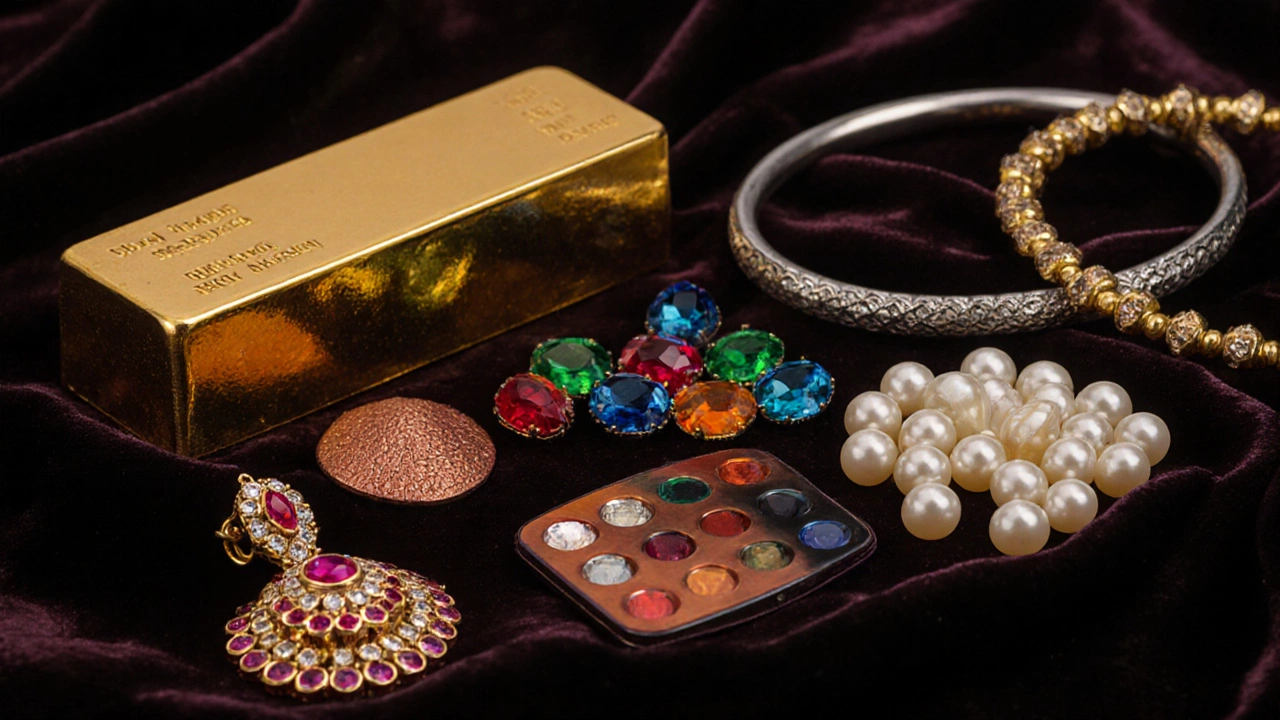
Gemstones and Decorative Elements
Kundan work, a traditional setting technique, embeds faceted gemstones into a gold foil base. The result is a dazzling surface that catches light from every angle. Common stones include rubies, emeralds, and sapphires, each linked to a deity’s attribute - red for Goddess Durga’s power, green for Vishnu’s prosperity.
Pearls are another staple, especially in bridal sets from Tamil Nadu. Their soft luster balances the bold metalwork and symbolizes purity. Navaratna - the nine‑gem ensemble of diamond, ruby, pearl, emerald, blue sapphire, hessonite, cat’s eye, coral and yellow sapphire - often appears in a single pendant or masala, believed to bring holistic blessings.
Enamel (known as ‘meenakari’) adds vibrant colour patches to motifs like lotus flowers or peacocks. The technique involves fusing powdered glass onto metal at high temperature, creating a glass‑like finish that resists wear.
Regional Variations in Material Choices
South Indian temple jewelry (Tamil Nadu, Karnataka, Andhra Pradesh) leans heavily on 22‑k gold, heavy chain work, and large temple motifs such as Ganesha, Lakshmi and the ‘pichwai’ panel. Because the climate is hot, artisans favor gold’s resistance to corrosion.
North Indian temple jewelry (Rajasthan, Gujarat, Uttar Pradesh) incorporates more silver, copper, and bright enamel work. The pieces are often lighter, making them suitable for dances and processions where mobility matters.
In Odisha, the famous ‘pattachitra’ influence brings intricate scroll patterns that are carved into brass before being gold‑plated, creating a distinctive matte finish.
How Materials Influence Value and Care
Gold purity directly impacts resale value. 22‑k gold commands a higher price per gram than 18‑k or 14‑k, but it’s also softer, so heavy wear can cause scratches. When you clean a gold pendant, use a soft cloth and mild soap; avoid abrasive chemicals that can damage the intricate filigree.
Silver requires regular polishing to keep its shine. A silver‑based temple set should be stored in anti‑tarnish pouches and occasionally wiped with a silver‑cleaning cloth.
Gemstones need individual attention. Kundan stones are set in tiny prongs; a gentle brush can remove dust without loosening them. Pearls should never be exposed to perfume or perspiration; wipe them with a dry cloth after wearing.
Enamel surfaces are brittle. If you drop a piece with enamel, the glaze can chip. Keeping the jewelry in a padded box separates enamel work from hard metal edges.
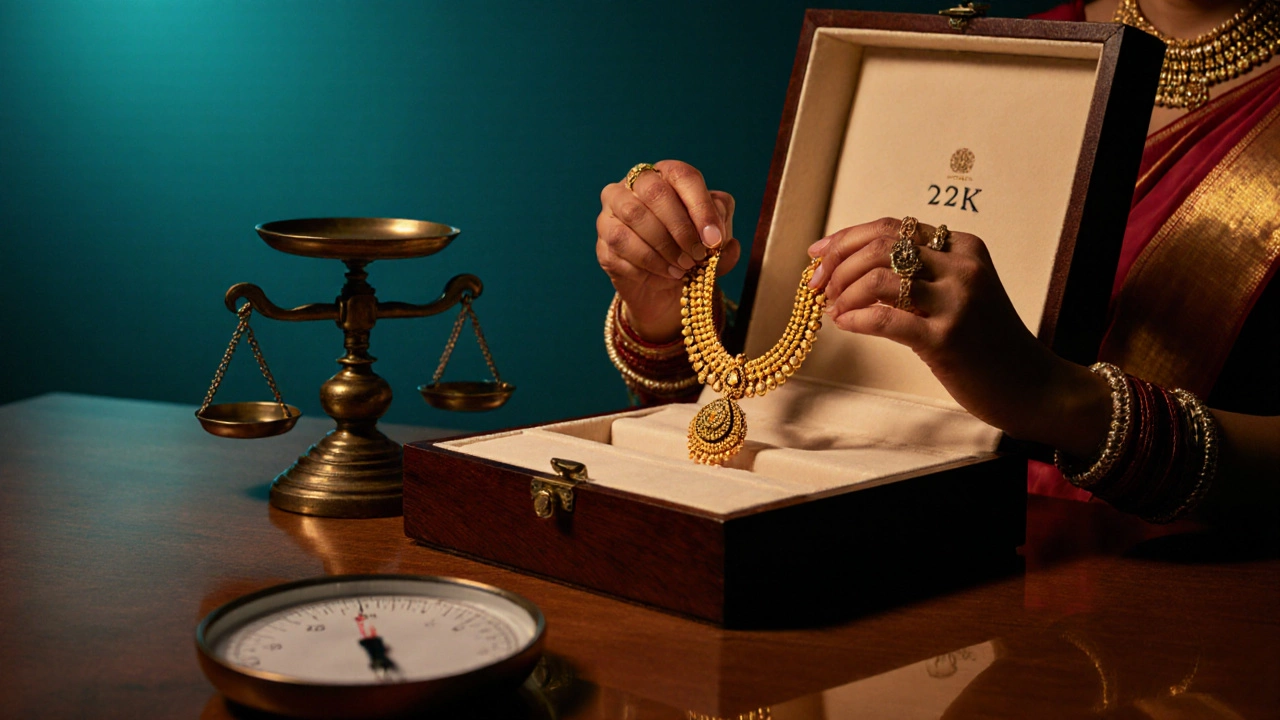
Tips for Choosing Authentic Temple Jewelry
- Check the hallmark stamp on the clasp - 22K, 916 (22‑k gold), or 925 (sterling silver).
- Weigh the piece. Gold feels heavier than silver or copper‑based alloys.
- Look for consistent detailing. Hand‑crafted motifs will have slight variations, while mass‑produced copies often show uneven lines.
- Ask for a certification from a reputable jeweler or a gemological institute if gemstones are involved.
- Buy from established sellers who specialize in South Indian temple jewellery; they usually provide a return policy and detailed provenance.
Frequently Asked Questions
What metal is most common in traditional temple jewelry?
Gold, especially 22‑k, dominates South Indian designs, while silver and brass are more frequent in North Indian styles.
Can I wear temple jewelry daily?
It’s possible, but heavy gold sets are best saved for special occasions. Silver and lighter pieces can be worn more often if you keep them clean and store them properly.
How do I verify the purity of gold in a temple piece?
Look for a hallmark stamp (e.g., 22K, 916). You can also get a karat test from a trusted jeweler, which involves a touch‑stone or electronic tester.
What is kundan setting and why is it popular?
Kundan is a setting technique where gemstones sit in a gold foil base. The method creates a high‑gloss surface that highlights each stone, making it a favorite for bridal temple jewellery.
How should I store temple jewelry to preserve it?
Separate each piece in a soft pouch, keep gold in a dry place, and place silver in anti‑tarnish bags. Avoid exposure to humidity, direct sunlight, and chemicals.
Materials Summary Table
| Material | Typical Purity / Grade | Key Visual Trait | Durability | Care Tips |
|---|---|---|---|---|
| Gold | 22‑k (916) or 18‑k (750) | Rich yellow luster | Soft, prone to scratches | Gentle soap, soft cloth, avoid harsh chemicals |
| Silver | Sterling 925 | Bright white, can tarnish | Medium, tarnishes over time | Polish regularly, store in anti‑tarnish pouch |
| Copper/Brass Base | Alloy 70‑80% copper/brass | Reddish or yellowish tone under plating | Harder than pure gold, good for heavy pieces | Keep dry, check for wear on plating |
| Kundan Setting | Gold foil base with faceted stones | High‑gloss sparkle | Durable if stones are secured | Use a soft brush for cleaning, avoid impact |
| Enamel (Meenakari) | Glass‑like powder fused at 800°C | Vivid colour patches | Brittle, can chip | Store separately, avoid knocks |
Understanding what temple jewelry is made of helps you pick pieces that fit your budget, style and care routine. Whether you’re shopping for a wedding set or a heritage heirloom, knowing the metals, gemstones and regional nuances gives you confidence to make a smart purchase.
